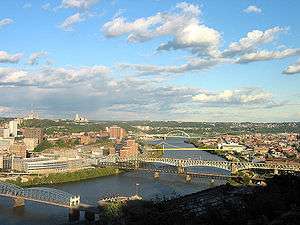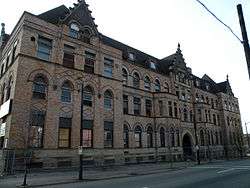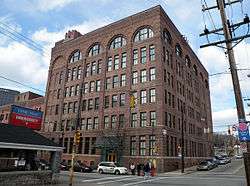Uptown Pittsburgh
Uptown or The Bluff (also known by its former name Soho and prior to the 20th century as Boyd's Hill[2]) is a neighborhood in the city of Pittsburgh, Pennsylvania to the southeast of the city's Central Business District. It is bordered in the north by the Hill District and located across the Monongahela River from South Side. The predominant area zip code is 15219.
Uptown Bluff | |
|---|---|
 Uptown (visible on the left side of the image) overlooking the Monongahela River. | |
 | |
| Coordinates: 40.436°N 79.989°W | |
| Country | United States |
| State | Pennsylvania |
| County | Allegheny County |
| City | Pittsburgh |
| Area | |
| • Total | 0.327 sq mi (0.85 km2) |
| Population (2000)[1] | |
| • Total | 6,600 |
| • Density | 20,000/sq mi (7,800/km2) |
This area is home to Mercy Hospital as well as Duquesne University. It also includes a residential community that was once flourishing during the first half of the 20th century. Uptown is also the home of the Pittsburgh Fire Bureau 4 Engine and 4 Truck.
| Year | Pop. | ±% |
|---|---|---|
| 1940 | 9,391 | — |
| 1950 | 8,949 | −4.7% |
| 1960 | 5,955 | −33.5% |
| 1970 | 4,379 | −26.5% |
| 1980 | 4,723 | +7.9% |
| 1990 | 3,220 | −31.8% |
| 2000 | 6,423 | +99.5% |
| 2010 | 6,600 | +2.8% |
| [3][4] Source: | ||
History
The area was known to American frontiersmen and colonists as Ayer's Hill in honor of a fortification built by the English commander Ayers in the mid-1700s. Sometime near the Revolutionary War and throughout the 19th century the area was referred to as Boyd's Hill in the expanding frontier and then industrial city. The name is said to have been given to the neighborhood after a newly arrived businessman swayed by Hugh Brackenridge, left his downtown office and hanged himself on the hill.[2]
Uptown was first developed by James Tustin, an eccentric English émigré who built an estate in the area in the late eighteenth or early nineteenth century. His home featured an English taste in architecture and a fruit orchard, and was acknowledged at the time to have been "the most beautiful place in Pittsburgh," according to a 1915 article in the Pittsburgh Gazette–Times.[6] Tustin named his estate "Soho" after his previous residence in Britain, and the name came to be generally applied to the neighborhood.[6]
The neighborhood was originally part of Pitt Township, but was annexed in 1846. The addition was precipitated by the city's efforts at regrowth following a cataclysmic fire in 1845, which destroyed 56 acres (230,000 m2) and 1,000 buildings.[7]
A 1922 guidebook, A History of Pittsburgh and Environs, noted that the area's houses were "old and not attractive, and are largely populated by foreign mill workers and their families",[6] and a 1977 guide remarked that it was once "a pleasant residential area for many wealthy Pittsburghers" but "as industry moved in, the wealthy moved out".[6] The neighborhood was adversely affected by Pittsburgh's urban renewal campaign in the 1960s, and in the estimation of some, "has never been reassembled".[8]
Construction projects in the area include expansion by Duquesne University, and development surrounding the newly completed arena for the Pittsburgh Penguins.[9]
Neighborhood character
Fifth Avenue is home to law offices such as nationally recognized Schiffman Firm, LLC and a few restaurants and bars, but vacant storefronts and small street parking lots for Downtown commuters are prevalent as well.[8] Brick rowhouses are common in the neighborhood.
There are significant efforts in the community to reassert a sense of identity,[8] and residents range from Downtown workers and long-time residents to university students and health professionals.[7]
Surrounding and adjacent Pittsburgh neighborhoods
Uptown has four land borders with Downtown Pittsburgh to the west and northwest, the Crawford-Roberts section of the Hill District to the north, West Oakland to the northeast and South Oakland to the east.
The entire Bluff runs adjacent to the western section of the South Side Flats across the Monongahela River; the two neighborhoods are accessible to each other by the South Tenth Street and Birmingham Bridges.
Gallery
 Fifth Avenue High School, built in 1894, at 1800 5th Avenue.
Fifth Avenue High School, built in 1894, at 1800 5th Avenue. Reymer Brothers Candy Factory, built circa 1910, at 1425 Forbes Avenue.
Reymer Brothers Candy Factory, built circa 1910, at 1425 Forbes Avenue. Kaufmann's Department Store Warehouse, built circa 1910, at 1401 Forbes Avenue.
Kaufmann's Department Store Warehouse, built circa 1910, at 1401 Forbes Avenue.- Armstrong Tunnel, built in 1926, between Forbes and 2nd Avenues at S. 10th Street.
- South Tenth Street Bridge, opened in 1933, over the Monongahela River at S. 10th Street.
See also
References
| Wikimedia Commons has media related to Bluff (Pittsburgh). |
- "PGHSNAP 2010 Raw Census Data by Neighborhood". PGHSNAP Utility. Pittsburgh Department of City Planning. 2012. Retrieved 21 June 2013.
- http://www.postgazette.com/pg/11359/1199216-53.stm
- https://docs.google.com/spreadsheet/ccc?key=0Ag0xdSSLPcUHdEo0STlkRVBpcVZEcUtwTG9wWjJTd2c#gid=0
- "Census:Pittsburgh" (PDF). Archived from the original (PDF) on August 10, 2007. Retrieved 2 September 2012.
- "Pittsburgh Census Tracts". pitt.libguides.com. Retrieved January 2, 2018.
- Potter, Chris (2007-05-24). "Pittsburgh has a neighborhood named "Soho"..." "You Had to Ask". Pittsburgh City Paper. Retrieved 2008-09-01.
- "Uptown". Neighborhoods. Pittsburgh City Council District 6. Retrieved 2008-09-01.
- Ackerman, Jan (2003-06-12). "Group taking steps to improve Uptown". Pittsburgh Post-Gazette. Retrieved 2008-09-01.
- Conte, Andrew (2007-11-14). "New Uptown arena to match neighborhood". Pittsburgh Tribune-Review. Retrieved 2008-09-01.
Further reading
- Post Gazette article on the 19th century history of the area
- Toker, Franklin (1994) [1986]. Pittsburgh: An Urban Portrait. Pittsburgh: University of Pittsburgh Press. ISBN 0-8229-5434-6.
- Post-Gazette on residential renovations in the Bluff
.jpg)